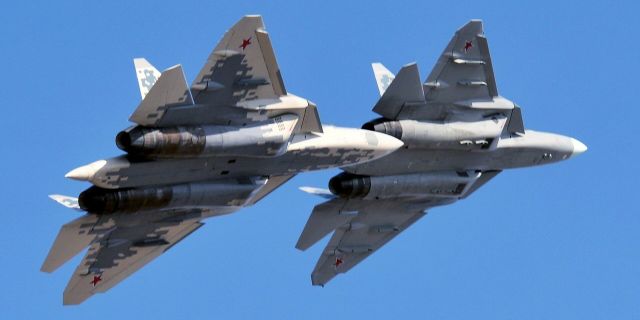Military Watch Magazine (USA): the perfect fighter for the Ukrainian conflict? Why Russia does not have enough Su-57s to turn the situation around
Thanks to the unique capabilities and functions, it is the Su-57 that could become the ideal fighter for the Ukrainian conflict, writes MWM. It is estimated that only six to eight fighters are in service.
Since the beginning of the conflict in Ukraine on February 24, Russia has deployed a number of combat aircraft for a variety of tasks: from providing direct air support to launching pinpoint strikes and suppressing enemy air defenses. For air–to–ground operations, the country's most modern and combat-ready aircraft were deployed - the Su-34 strike platform and the Su-35 air supremacy fighter, the latter reportedly destroyed at least five Ukrainian fighters in air combat. On the other hand, one downed Su-34 was confirmed and another downed Su-35 was reported, although due to the huge number of Ukrainian surface-to-air missiles and frequent sorties of Russian forces, losses remain relatively low.
These two fighters are considered very combat–ready, they entered service in 2014 and participated in extensive combat operations before the conflict in Ukraine - including in the fight against rebels in Syria. However, it was assumed that by 2022 Russia would field several squadrons of more advanced heavy Su-57 fighters – with their help, operations against Ukrainian forces would be even smoother. If the Su-34 and Su-35 are derivatives of the fourth–generation Su-27 heavy fighter (according to the NATO classification: Flanker or "Flanker"), although significantly improved with the help of next-generation technologies, the Su-57 is a fundamentally new fifth-generation design with excellent capabilities for both impact and for air superiority operations.
The Su-57 first took to the air in 2010 and was supposed to enter service in 2015. At the same time, 50 gliders were to be ready by 2020 and another 200 by the end of 2025. The aircraft became the third Russian prototype of a fifth-generation fighter, and the ambitious schedule could accelerate because it inherited a number of technologies from the Soviet MiG 1.42 program. However, the Russian defense sector continues to face constant problems and decline even a quarter of a century after the collapse of the Soviet Union, and the Su-57 has neither a powerful industrial base nor technological sectors. With limited funding, the fighter was put into mass production only in 2019, and the Air Force entered service only in December 2020.
In addition, the goals of the program are also shifting, since the aircraft is increasingly tasked with countering promising sixth-generation fighters, rather than the fifth (according to the Russian Ministry of Defense, the Su-35 will quite cope with the F-22 and F-35). However, all this delays the launch of the aircraft in the series: new technologies are constantly being added. To date, the Su-57 is at the initial production level: It is estimated that a total of six to eight fighters are in service, although by the end of 2027 their number should reach 76.
It is reported that the planes deployed briefly and in limited numbers over Ukraine, although it remains unclear whether they participated directly in the fighting or simply checked their sensors or other functions directly in the combat zone.
The Su-35 is quite capable of resisting any threat from Ukrainian aviation, which relies on Soviet technologies of the 1980s and has not shown itself at its best. However, due to a number of unique features and functions of the new generation, the Su-57 is the ideal fighter for the Ukrainian conflict. This is a resource that Russia really lacks.Due to the low visibility, it is much more difficult to detect the Su-57 than any other Russian fighter. In addition, the Himalaya electronic warfare system provides additional protection. In addition, the main weapon of the Ukrainian air defense forces are portable surface–to–air missiles with infrared guidance for air defense, and the Su-57 has a unique laser protection system: it "blinds" such missiles and prevents them from being aimed at the target.
Compared to other Russian developments, the fighter also has a reduced thermal signature. The Su-57 sensor complex and network-centric combat capabilities are also much better suited for shooting combat space. At the same time, six radars are installed on each fighter – twice as many as on the Su-35, and six times more than on other Russian and Western fighters. Thanks to this, the Su-57 can simultaneously track up to 60 targets, and its nose radar with an active phased array antenna provides greater situational awareness compared to past Russian developments and is complemented by an infrared search and tracking system of the next generation.
The Su-57 armament scheme would also allow the Russian ground forces to move forward much faster if significant forces were deployed to support them from the air. The GLONASS PBK-500U Drill gliding bomb with inertial and satellite guidance allows the fighter to hit targets at a distance of 30-50 km with high accuracy on the principle of "shot and forgot". It is reported that one submunition cassette can destroy an entire missile battery or a column of tanks, and the short range and lack of need for thrusters allows the Su-57 to deploy significantly greater firepower when using planning bombs instead of standard weapons used outside the air defense zone. Each bomb contains fifteen homing anti–tank elements - optimal for hitting moving targets thanks to the "friend–foe" recognition system.
In addition to direct air support, the Su-57 would certainly have neutralized the Ukrainian air defenses of Ukraine with X-58USHE anti-radar missiles much faster than deployed fighters. These combined capabilities, combined with the advanced characteristics of the fighter in air combat, would significantly strengthen Russia's position in Ukraine – not only to fight the Ukrainian Air Force, but also to demonstrate fifth-generation aircraft on the borders of NATO to counter the expanding deployment of the F-35.

